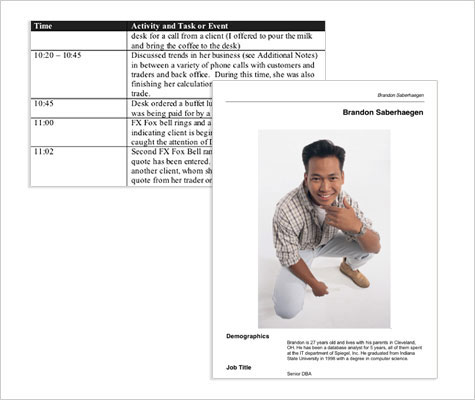Lesson one from the 9 Lessons from 9 Years of Interface Design retrospective: Insights come in all shapes and sizes.
In 2000, I flew out to San Jose to work on a product for a company called Currenex. They had a successful terminal-based client application that enabled banks and their customers to trade currencies and were looking to bring the experience online as a Web application. What greeted me there in addition to representatives from business, marketing, and engineering teams was a fifty-page report of existing user “interviews”.
In truth, however, the report was more of an activity log than a set of interviews. Each user’s daily activities were chronicled minute by minute in vivid detail. Reading through the report, I was instantly transported into the world of currency exchange. I heard the phones ring, saw the hurried typing, and most importantly began to empathize with the users of the current system.
The report became my guide through this unfamiliar domain and drove many of the design decisions found within the product. For instance, the speed with which users had to respond to trade requests and the number of concurrent trades they engaged in were directly responsible for the use of small multiples that doubled as easy-to-access targets within the interface.

Needless to say, I was hooked. My prior experiences with user research had consisted mostly of survey data, usability tests, and log analysis -all of which fell well short of providing the level of empathy the Currenex field studies afforded me. I had immersed myself in the details of the application’s users and emerged with a stronger understanding of where to take the product design.
A while later, I found myself in Chicago -this time faced with taking a data warehouse analysis application with usability issues from the Windows desktop to the Web. Instead of a minute-by-minute activity report, I was handed a set of user personas. These high-level summaries of the application’s stakeholders and end users provided the same type of design direction I had been afforded with the Currenex field studies. The characteristics that defined successful database analysis for these users came to define the look and feel of the application.
The basic lesson is that insights can be discerned at multiple levels: within detailed ethnographic observations and within high-level summaries or abstractions. Insights can be found in many places: customer support data, application logs, field studies, survey data, focus groups, usability tests, user interviews, personas, market segments, academic research, best practice audits, and more. In all cases, however, it is the responsibility of the interface designer to take appropriate direction from the data and to distill the important insights found therein into meaningful design decisions.